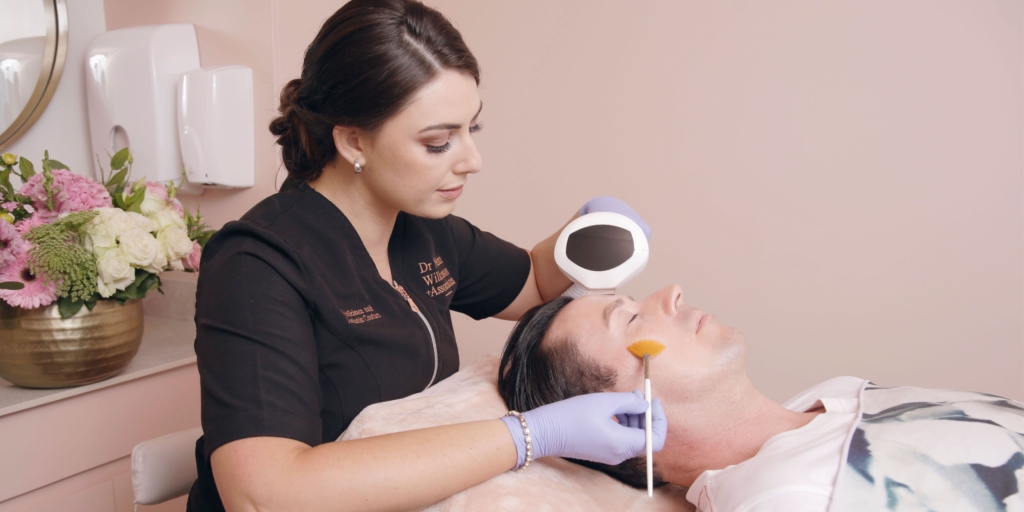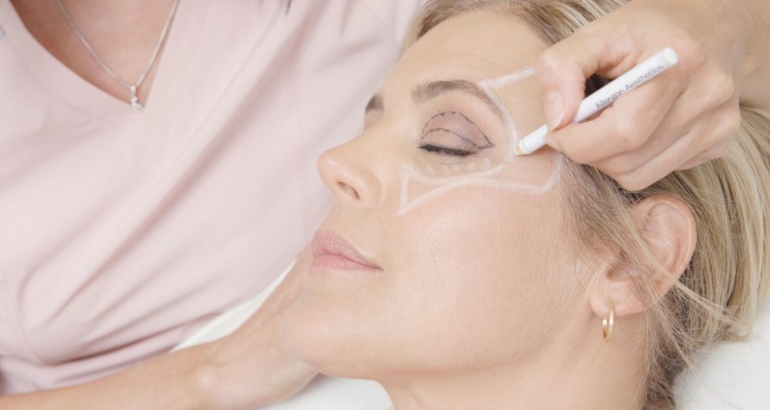by Specialist Cosmetic Surgeon, Dr Nerina Wilkinson
Welcome to the fabulous world of facelift recovery! Now, I know what you’re thinking: “Recovery? That doesn’t sound very exciting!” But trust me, this is the time to embrace self-care, indulge in some guilt-free relaxation, and let your body work its magic.
Think of it as a temporary membership to the “Face Lifters Club,” whilst you transform into a refreshed and rejuvenated version of yourself. Now is the time to perfect your “I’m in recovery mode” fashion game. You now have legitimate excuse to rock those oversized sunglasses, trendy hats, and stylish scarves like a fashion icon. Who knew recovering from a facelift could be so fashionable?
If you are considering a cosmetic facelift surgery or have recently undergone the procedure, you may be curious about the recovery process and how to optimize your healing for the best possible results. This Guide to Facelift Recovery is here to provide you with valuable insights and practical tips to ensure a smooth and successful recovery journey.
By diving into this facelift recovery guide, you will gain a deeper understanding of the facelift recovery process, including the expected downtime, potential challenges, and the necessary steps to promote optimal healing. From practical advice on managing post-surgical discomfort to recommendations for maintaining results in the long term, this guide offers a wealth of information to empower you on your recovery journey. Discover the secrets to a successful facelift recovery and unlock the potential for a more rejuvenated and confident you.
Table of contents
- What is Facelift Recovery?
- Week 1: The Start of Your Facelift Recovery Process
- Managing the Initial Healing Process in Post-Operative Care Facilities
- Home Recovery After Facelift Surgery
- Managing Discomfort, Bruising, and Swelling
- Week 3: Easing off Travel Restrictions
- 1 Month & Beyond – Managing Long-Term Recovery and Results
- The Importance of a Healthy Diet & Mindset
- Final Thoughts
What is Facelift Recovery?
Facelift recovery is a transformative journey, both physically and emotionally. As a female plastic surgeon, I understand the importance of providing empathetic care during this critical healing period. It is my passion to support women on their path to rejuvenation and help them embrace their inner and outer beauty.
The facelift recovery process involves various stages, each crucial for the body to heal from the changes made during the surgery. Initially, patients may experience swelling, bruising, and discomfort. However, with proper post-operative care and adherence to guidelines, these symptoms gradually subside.
Wound care is essential during this time, and I ensure that my patients receive detailed instructions to promote healing and minimize scarring. As a dedicated surgeon, I prioritize open communication and encourage my patients to voice any concerns or questions they may have throughout their recovery journey.
The facelift recovery timeline varies from person to person. Factors such as overall health, the extent of the surgery, and commitment to post-operative care play a significant role. While some patients may recover within a few weeks, others may require several months for a complete rejuvenation.
My role as a female plastic surgeon extends beyond the operating room. I provide a comprehensive facelift recovery guide, offering personalised advice and support. Together, we navigate the ups and downs, ensuring a smooth transition back to everyday activities.
If you’re considering a facelift, rest assured that I will be there for you every step of the way. Together, we will embark on a transformative experience, enhancing your natural beauty and embracing a renewed sense of self.
Week 1: The start of the facelift recovery process
Congratulations on taking the first step towards rejuvenation with a facelift! As a female plastic surgeon, I understand the significance of the initial healing phase following your surgery. This period marks the beginning of your transformation, as your body starts to recover and adapt to the changes made during the procedure.
Immediately after your facelift, you may experience some aftereffects such as swelling, bruising, and mild discomfort. These are normal and expected as your body adjusts to the surgical alterations. Rest assured that these temporary effects will gradually subside as your recovery progresses.
Professional postoperative care is vital during this early phase. I emphasize the importance of follow-up appointments to monitor your progress and provide any necessary treatments or adjustments. Your well-being is my priority, and I am committed to guiding you through each step of your recovery journey.
Preparing for home care is also crucial for a successful start to your facelift recovery. I provide detailed instructions on wound care, medication management, and any necessary lifestyle modifications. These guidelines will help optimize your healing process and minimize potential complications.
It’s important to note that everyone’s recovery timeline is unique. Factors such as your overall health, the extent of the surgery, and your commitment to postoperative care will influence the duration of this initial healing phase. Patience and adherence to your personalized recovery plan will be key as you embark on this transformative journey.
Together, we will embark on a path of renewal and celebrate the radiant, revitalized you that lies ahead.
Managing the Initial Healing Process in Post-Operative Care Facilities
After your facelift surgery, you may experience sensations such as pain and facial tightness. Rest assured, these effects are typical and part of the healing process. At Dr. Nerina Wilkinson’s practice, we prioritize pain management and provide comprehensive post-operative care to ensure your comfort and well-being.
To optimise your recovery, we recommend spending the first few nights (1-4) in a professional postoperative care facility. This environment offers round-the-clock support from trained medical professionals who are experienced in post-facelift care. They will monitor your progress, manage pain, and provide any necessary treatments.
In addition to professional care, we implement techniques like ice and light therapy. These methods, practiced by Dr. Nerina Wilkinson’s team, help speed up the healing process and reduce swelling. We also ensure proper wound care to promote optimal healing of your facelift incisions and minimize scarring.
Remember, everyone’s healing journey is unique, and we are here to guide you every step of the way. Trust in our team’s dedication to your well-being, and together, we will help you achieve the best possible results from your facelift procedure.
Home Recovery After Facelift Surgery
Your facelift surgery marks a significant step towards achieving your desired rejuvenation. As you transition to home recovery, it’s important to follow specific care instructions to ensure optimal healing and the best possible results.
To manage any discomfort, pain medication will be prescribed, and it’s crucial to adhere to the recommended dosage and schedule. Additionally, keeping your head elevated while resting or sleeping can help reduce swelling and promote proper circulation.
During the first five days post-op, it’s normal to experience swelling and discomfort. Rest assured that these are typical aspects of the healing process, and they will gradually subside as your recovery progresses. To support your healing, avoid strenuous activities that could strain your facial muscles and incisions. Follow the care instructions provided, which may include gentle facial cleansing, wound care, and specific guidelines for bathing and dressing changes.
Remember, everyone’s recovery timeline may vary, and patience is key during this phase. Ensure you have a support system in place, (possibly a best friend or a supportive partner) and don’t hesitate to reach out to our team if you have any concerns or questions.
By following these home recovery instructions with care and commitment, you are setting the foundation for a successful and transformative healing journey. Embrace the process, prioritize self-care, and before you know it, you’ll be enjoying the beautiful results of your facelift surgery.
Week 2: Navigating Through Early Recovery
You made it! You have reached the second week of your facelift recovery journey! This period marks an important transition from the initial healing phase to the early stages of recovery. In this section, we will provide insights into what to expect during this critical period and offer guidance on how to effectively manage your progress.
Managing pain and discomfort remains a priority during the early recovery phase. Remember, this is not a painful procedure, and most patients are able to decrease taking the prescribed pain medications. Dr Wilkinson will continue to advise you on selective pain management if you still experience any discomfort.
Bruising and swelling are common during this stage, but they will gradually subside over time. Applying cold compresses, as advised, can help reduce swelling and minimize bruising. Remember to be patient with your body as it heals, and trust that these temporary effects will fade as you progress further into your recovery.
During the second week, you will start to feel more presentable and confident. It’s essential to continue following the post-operative care instructions provided. These may include gentle skincare routines, avoiding direct sunlight, and gradually reintroducing light physical activities.
Remember, everyone’s recovery timeline is unique, and it’s important to listen to your body’s signals.
As you navigate through the second week of your facelift recovery, stay positive and be kind to yourself. Focus on self-care, embrace the progress you have made, and look forward to the beautiful results that await you.
What to Expect During the Second Week After Your Facelift
As you progress into the second week of your facelift recovery, it’s important to have a realistic understanding of what to expect during this phase. While individual experiences may vary, there are some common patterns that most patients encounter. Pain, swelling, and bruising are still likely to be present, although they should gradually diminish as your healing progresses.
By the second week, many patients start feeling more presentable and confident. While residual swelling and bruising may still be noticeable, you may feel ready to see friends and family. However, it’s important to remember that everyone’s recovery timeline is unique, and it’s essential to follow your plastic surgeon’s care instructions regarding social activities. During this phase, continue to care for your facelift incision sites, including cleansing, dressing changes, and protecting the incisions from direct sunlight.
The second week after your facelift is a significant milestone in your recovery journey. Be patient with your body as it continues to heal, and trust that with time, the visible signs of surgery will fade. Stay committed to post-operative care instructions and maintain open communication with your plastic surgeon to ensure a smooth and successful recovery.
Remember, each day brings you closer to the results you desire.
Managing Discomfort, Bruising, and Swelling During Facelift Recovery
Recovering from a facelift involves managing discomfort, bruising, and swelling as your body heals. Here are some strategies to help you navigate this phase of your facelift recovery:
To ease pain and discomfort, follow your plastic surgeon’s instructions regarding pain medication. Gradually decrease your reliance on medication as directed. However, if you experience significant pain or shooting pain, contact your surgeon for guidance.
Patience is crucial during this time, so avoid overexertion and strenuous exercise, as it can exacerbate discomfort and prolong the healing process. Instead, focus on light activities and gradually increase your level of physical exertion as advised by your surgeon.
To manage bruising and swelling, apply cold packs to the affected areas every 3-4 hours. Sleeping with your head elevated on pillows can also help reduce swelling. Be consistent with these practices to facilitate the healing process. Keep in mind that bruising and swelling will gradually subside over time. While each person’s recovery timeline may vary, a general guideline is that bruising typically resolves within two to three weeks, while swelling may take several weeks to fully disappear.
Remember to communicate any concerns or changes in your symptoms to your plastic surgeon.
By managing discomfort, bruising, and swelling with care and following your surgeon’s guidance, you can support a smoother recovery and look forward to the beautiful results that lie ahead.
Week 3: Easing Off Travel Restrictions
Week 3 is when you wear your “Face Lifters Club “badge with more confidence. You are starting to rock those oversized sunglasses and scarves.: During week 3, we understand the eagerness to regain your active lifestyle. With gentle movements and light exercise, you can enhance your recovery while respecting the boundaries we have set to promote healing without overexertion.
When to travel after your procedure is important. For those who have visited Dr. Nerina Wilkinson + Associates in Cape Town but are based elsewhere, we are thrilled to share that traveling is now a viable option. We recognize the importance of returning home or exploring new horizons, and we will provide you with detailed guidance and precautions to ensure your safety and comfort during travel.
While we have taken every precaution to minimize risks, unexpected complications can arise during the recovery process. Possible complications from facelift surgery may include infection, scarring, hematoma, nerve damage, hair loss around the incision sites, and temporary or permanent facial asymmetry. Please rest assured that our team is available to provide support, guidance, and prompt attention should you require it.
To ensure your continued progress and address any questions or concerns regular follow-up appointments are scheduled over the next few weeks after your facelift procedure. This personalised visit will allow us to closely monitor your healing, provide additional guidance, and offer reassurance as you move forward.
As you navigate this crucial phase, we understand the emotions and hopes associated with your facelift journey, and we are honored to be by your side throughout this transformative process.
1 Month & Beyond – Managing Long-Term Recovery and Results
The finish line is in sight. As you reach the one-month mark post-op, it’s time to focus on seamlessly transitioning back to your daily activities while nurturing your healing skin. Our entire team is here to provide guidance for long-term recovery and maintaining the results you’ve achieved.
We’ll share valuable advice on how to preserve and enhance the outcomes of your facelift. From skincare routines to lifestyle choices, we’ll explore strategies to optimize and prolong the rejuvenating effects of the procedure.
At this point, you may be wondering what the timeline for full recovery is… While you may have experienced significant improvements within the first month, it’s essential to understand that complete recovery takes time. We’ll reiterate the timeline for sensation restoration, tissue healing, and scar maturation, which can extend up to six months. Patience and adherence to post-operative care guidelines are key.
Throughout this journey, remember that Dr. Nerina Wilkinson and her team are dedicated to your long-term well-being. By following their expert advice, you can navigate the months ahead with confidence, knowing you have the tools and support necessary to achieve and maintain the best possible results. Let’s discover what you can look forward to.
Adopting a personalised skincare routine
Following the right prescribed skincare routine will ensure the best results and maintain a healthy, radiant complexion. The prescribed skincare and sun protection are essential in preserving the lasting results of your facelift. Our experienced Skin Science team at Dr Nerina Wilkinson + Associates will emphasize the role of antioxidants in nourishing and protecting your skin, providing tips on incorporating them into your daily routine.
By prioritizing a comprehensive skincare regimen and safeguarding your skin from sun damage, you can extend the benefits of your facelift, enjoying a vibrant and youthful appearance for years to come.
Returning back to daily activities
Easing back into exercise and daily activities after facelift surgery is crucial for a smooth recovery and your well-being. You won’t be alone if you are experiencing a touch of “cabin fever” and need to embrace your “previous life again “. As much as you have loved your “me time “, life must go on.
During this time you can gradually resume your routine, including work, exercise, and social interactions. It’s important to listen to your body and recognize signs that indicate the need to take it easy, such as increased discomfort or swelling. Start by slowly reintroducing daily activities, such as light household chores and desk work, before gradually increasing your level of exertion. Easing back into exercise and daily activities after facelift surgery requires careful consideration and attention.
As tempting as it may be to show off your newly rejuvenated face at the gym, don’t forget to consult with your surgeon about the ideal time to get back into it first. It may take anything from 3 – 6 weeks before you return to a strenuous exercise routine.
Don’t skip the sun protection
It is vital that you protect your incision sites from sun exposure by wearing a broad-brimmed hat and using sunscreen with a high SPF. Sunlight can darken scars and delay their healing process. Considering embracing the chic look of oversized sunglasses and floppy hats to protect your delicate facial skin. You’ll be a trendsetter in both style and sun safety.
When it comes to scarring, we will provide you with specific recommendations for scar management, including the use of silicone sheets, topical creams, or other treatments to minimize the appearance of scars.
Adopt clever hairstyles
Consult with a skilled hairstylist who can suggest hairstyles that cleverly conceal any visible scarring. Techniques such as layering, side-swept bangs, or strategic hair parting can help disguise incision sites for now. Experiment with hair accessories like headbands, scarves, or decorative hair clips to further divert attention from the surgical areas.
Who says you can’t turn your hairstyle into a work of art? Seek the assistance of a hairstylist who can work their magic and help you rock a hairstyle that not only flatters your face but also keeps any scars incognito.
By following these guidelines and pacing yourself, you can confidently embrace your daily activities while allowing your body to heal and adjust to its rejuvenated appearance.
The Importance of a Healthy Diet & Mindset
Maintaining a healthy diet and incorporating additional tips can make your recovery journey after a facelift more personal and enjoyable. Here are some tips for an even smoother facelift recovery:
Nourish Your Body: Treat yourself to a well-rounded and nourishing diet. Focus on wholesome foods that make you feel good from the inside out. Incorporate plenty of fresh fruits, vegetables, and lean proteins to support your body’s healing process.
Stay Hydrated: Hydration is key! Sip on water throughout the day to keep your body and skin hydrated. It’s a simple yet effective way to promote healing and maintain a healthy complexion.
The Power of a Positive Mindset: Embrace your inner cheerleader and remind yourself daily of your fabulous progress. Mirror, mirror on the wall, who’s the most radiant of them all? You, of course!
Embrace Self-Care: Take this opportunity to indulge in self-care practices that make you feel pampered and rejuvenated. Whether it’s practicing mindfulness, enjoying a relaxing bath, or spending time doing activities you love, prioritize self-care during your recovery journey.
Celebrate Progress: Celebrate the small victories along the way! Each step forward is a milestone worth acknowledging. Take pride in your progress and remember that healing takes time.
By personalizing your recovery journey with nourishing foods, staying hydrated, and embracing a positive mindset, you’re giving yourself the best chance for a successful and fulfilling facelift recovery.
Final Thoughts on Facelift Recovery
In conclusion, your facelift recovery journey is a personal and transformative experience. Let’s recap the key points we’ve covered:
You are in the Driver’s Seat: Remember, you play an active role in your own recovery. Follow the guidelines provided by Dr. Nerina Wilkinson and her team, take care of yourself, and be patient as your body heals.
The Support Squad: Think of Dr. Nerina Wilkinson and Associates as your personal glam squad. They’re here to make sure you shine, both inside and out! Don’t hesitate to reach out to them with any questions or concerns you may have. They have the knowledge and expertise to guide you through your healing journey. Reach out to them for guidance, encouragement, and the occasional pep talk when you need it.
Lights, Camera, Action! Take the Leap: It’s time to act! Pick up the phone and contact Dr. Nerina Wilkinson and Associates with any questions or curiosities you have about facelifts and the recovery journey. They are ready to provide you with the personalized care and information you need.
Blog Bonanza: Can’t get enough facelift talk? Head over to our blogs for some extra information. Discover the latest trends, explore the world of short scar facelifts, and how to face the future with confidence.
Remember, your facelift recovery is a unique journey, Embrace the process.
Contact us with any questions you might have.








